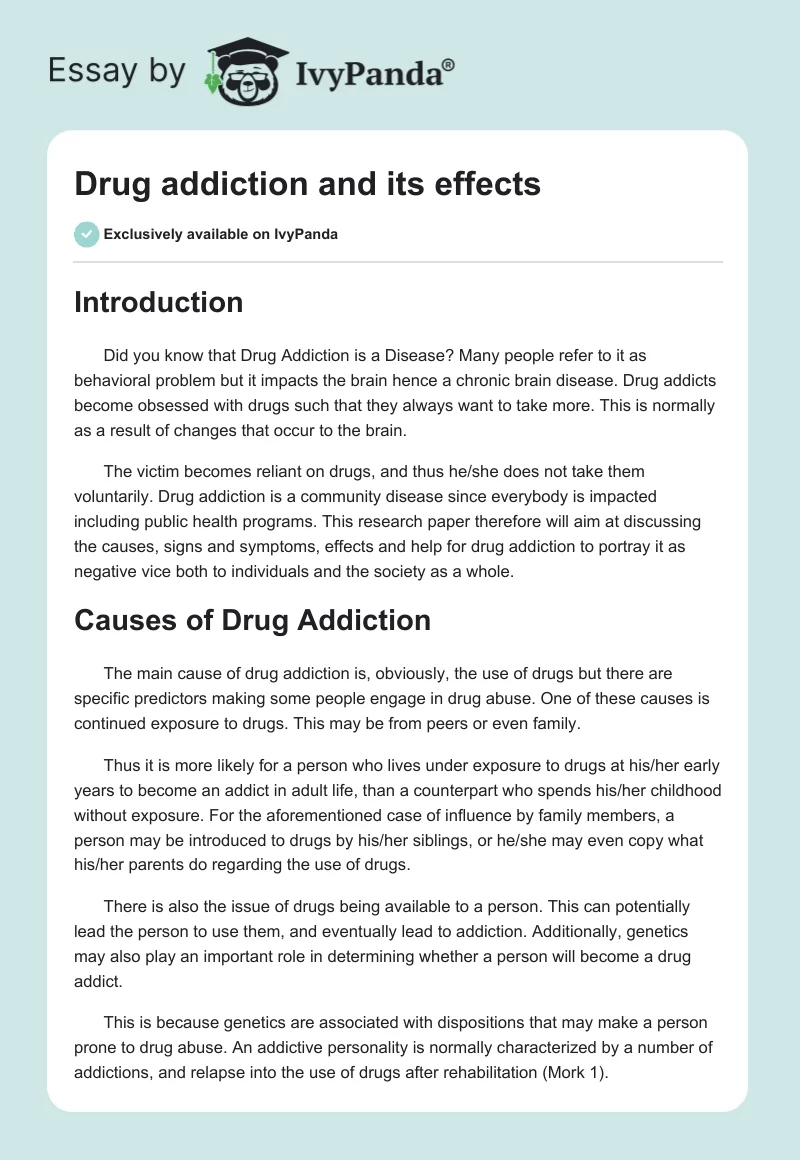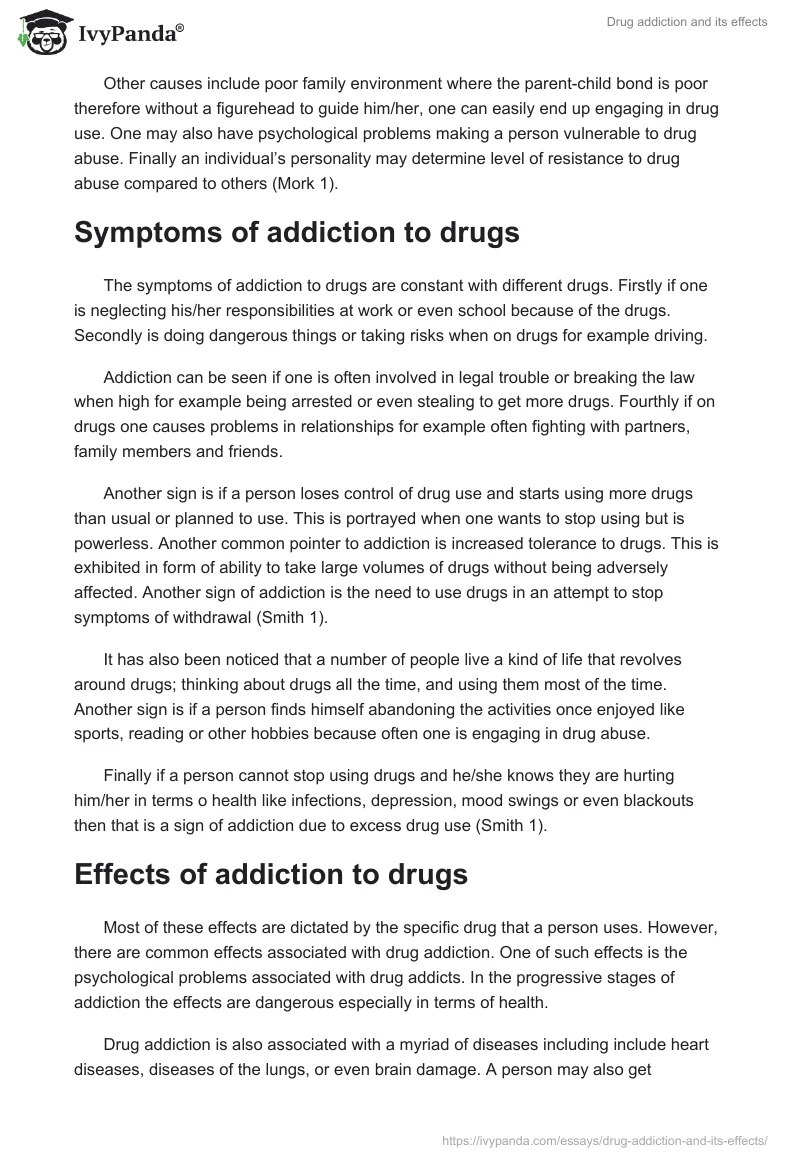Introduction
Did you know that Drug Addiction is a Disease? Many people refer to it as behavioral problem but it impacts the brain hence a chronic brain disease. Drug addicts become obsessed with drugs such that they always want to take more. This is normally as a result of changes that occur to the brain.
The victim becomes reliant on drugs, and thus he/she does not take them voluntarily. Drug addiction is a community disease since everybody is impacted including public health programs. This research paper therefore will aim at discussing the causes, signs and symptoms, effects and help for drug addiction to portray it as negative vice both to individuals and the society as a whole.
Causes of Drug Addiction
The main cause of drug addiction is, obviously, the use of drugs but there are specific predictors making some people engage in drug abuse. One of these causes is continued exposure to drugs. This may be from peers or even family.
Thus it is more likely for a person who lives under exposure to drugs at his/her early years to become an addict in adult life, than a counterpart who spends his/her childhood without exposure. For the aforementioned case of influence by family members, a person may be introduced to drugs by his/her siblings, or he/she may even copy what his/her parents do regarding the use of drugs.
There is also the issue of drugs being available to a person. This can potentially lead the person to use them, and eventually lead to addiction. Additionally, genetics may also play an important role in determining whether a person will become a drug addict.
This is because genetics are associated with dispositions that may make a person prone to drug abuse. An addictive personality is normally characterized by a number of addictions, and relapse into the use of drugs after rehabilitation (Mork 1).
Other causes include poor family environment where the parent-child bond is poor therefore without a figurehead to guide him/her, one can easily end up engaging in drug use. One may also have psychological problems making a person vulnerable to drug abuse. Finally an individual’s personality may determine level of resistance to drug abuse compared to others (Mork 1).
Symptoms of addiction to drugs
The symptoms of addiction to drugs are constant with different drugs. Firstly if one is neglecting his/her responsibilities at work or even school because of the drugs. Secondly is doing dangerous things or taking risks when on drugs for example driving.
Addiction can be seen if one is often involved in legal trouble or breaking the law when high for example being arrested or even stealing to get more drugs. Fourthly if on drugs one causes problems in relationships for example often fighting with partners, family members and friends.
Another sign is if a person loses control of drug use and starts using more drugs than usual or planned to use. This is portrayed when one wants to stop using but is powerless. Another common pointer to addiction is increased tolerance to drugs. This is exhibited in form of ability to take large volumes of drugs without being adversely affected. Another sign of addiction is the need to use drugs in an attempt to stop symptoms of withdrawal (Smith 1).
It has also been noticed that a number of people live a kind of life that revolves around drugs; thinking about drugs all the time, and using them most of the time. Another sign is if a person finds himself abandoning the activities once enjoyed like sports, reading or other hobbies because often one is engaging in drug abuse.
Finally if a person cannot stop using drugs and he/she knows they are hurting him/her in terms o health like infections, depression, mood swings or even blackouts then that is a sign of addiction due to excess drug use (Smith 1).
Effects of addiction to drugs
Most of these effects are dictated by the specific drug that a person uses. However, there are common effects associated with drug addiction. One of such effects is the psychological problems associated with drug addicts. In the progressive stages of addiction the effects are dangerous especially in terms of health.
Drug addiction is also associated with a myriad of diseases including include heart diseases, diseases of the lungs, or even brain damage. A person may also get HIV/AIDS which occurs after sharing of syringes during drug injection with an infected person (Kartha 1).
Secondly there are Psychological and Social effects where you find that once a person becomes an addict he/she cannot control use of drugs and hence powerless. If they do not use the drugs, they may start feeling restless, depressed, sweating, shaking, and anxious. This makes them crave for more usage of drugs.
In every country in the world most drugs are usually illegal and hence accessing them makes it expensive and, for those who cannot afford they may start stealing to buy drugs. This leads to increased crime rates in our society. Some people may also engage in prostitution or even sell their own properties to get money to buy drugs (Kartha 1).
Drug addiction affects a person’s social life negatively where one’s relationships with family and friends is impacted. An addict usually may turn violent when high and hence this may lead to break down of families, loosing friends and loved ones. This is also portrayed in the professional life of an addict where he/she cannot concentrate on the job due to the drugs. This brings down the performance of a person at work and that might cost him/her job (Kartha1).
Treatment of Drug Addiction
Drug addiction is treatable though difficult. The first step is for the addict to accept that he/she has a problem which if not treated is dangerous to the people around him including his/her own family. There are various forms and stages of treatment.
Treatment can be done through medication but it is used in conjunction with other treatment processes. The next is withdrawal where medication can be employed to suppress the withdrawal symptoms.
However medication is not advisable since sometimes patients who withdraw through medication are almost similar to those who have not been treated. Virtually all the medications used in drug addiction cases are designed to deal with the psychology of the addict so that he/she will not long for drugs (“Treatment Approaches to Drug Addiction” 1).
Another form of treatment is the treatment of the behavior of the addict. It is designed to help a patient “engage in the treatment process, modify their attitudes and behaviors related to drug abuse, and increase healthy life skills.
These treatments are designed in such a way that they have a cumulative effect of effectiveness of the rehabilitation process (“Treatment Approaches for Drug Addiction” 1). There are various behavioral approaches which can be used to treat drug addiction. Firstly we have Outpatient behavioral treatment which may include individual and group counseling, therapy, motivational interviewing and incentives.
Residential treatments are also used especially for more severe addicts. In these treatments, it is mandatory for a patient to spend time in a rehabilitation center until he/she is considered cured. An example is the TCs. “TCs differ from other treatment approaches principally in their use of the community—treatment staff and those in recovery—as a key agent of change to influence patient attitudes, perceptions, and behaviors associated with drug use” (“Treatment Approach to Drug Addiction” 1).
Prevention of Drug Abuse and Addiction
Firstly a person should recognize the signs which may include change in ones appearance, weight loss, sleeping at odd hours, losing interest in work or school, changes in a person’s social life and poor emotional health among others.
Secondly a person should spot the dangers where if the drugs are prescriptions from doctors he/she should follow it to the letter. If it is a drug like alcohol if possible avoid and to adults they should if they must drink the recommended amounts.
Thirdly is through communication which helps a lot in preventing drug use especially among young people. This should come from parents, teachers and all leaders in our society about the effects of drugs use (Vaux 1).
Conclusion
From the above causes, signs and symptoms, effects, treatment and ways of preventing drug abuse and addiction, it is clear that everybody in our society is somehow affected both directly and indirectly.
Millions of dollars are used by governments, charities and individuals to try and curb drug abuse and addiction but the issue still remains a challenge too hot to let go no matter the costs. We cannot let part of our society turn out to be like the picture in the next page. A drugs free society is a healthy society.

(Volkow 1)
Works Cited
Mork, Rachel. “Causes of Drug Addiction” n.d. Web.
Smith, Saisan. “Signs, Symptoms, and Help for Drug Problems and Substance Abuse” 2010. Web.
Kartha, Deepa. “Effects of Drug Addiction” 2009-2011. Web.
NIDA InfoFacts. “Treatment Approaches for Drug Addiction”. 2010-2011. Web.
Vaux, Robert. “What Are the Ways to Prevent Drug Addiction?”2005-2010. Web.
Volkow, Nora, “What Do We Know About Drug Addiction?” 2005. Web.

